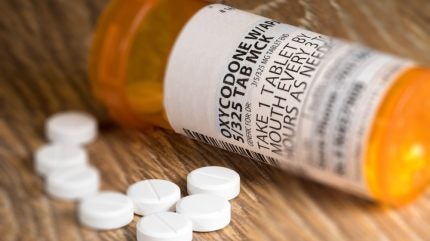
The opioid addiction treatment market will be worth $2.4bn in eight major world markets by 2033. This is according to GlobalData, Pharmaceutical Technology’s parent company, which forecasts that the market will grow at a compound annual rate (CAGR) of 1.8% from $2.0bn in 2023 to $2.4bn in 2033.
The growth is set to be driven primarily by an increase in diagnosed prevalent opioid use disorder (OUD) cases and an increase in treatment rates across the eight major markets: the US, France, Germany, Italy, Spain, the UK, Canada, and Australia.
However, GlobalData’s recent report, Opioid Addiction: Opportunity Assessment and Forecast, points out that market size is likely to see further growth as a result of the introduction of four late-stage pipeline products: cannabidiol, mazindol controlled release (CR), probenecid, and TRV-734.
These products could push combined sales in the eight major markets to around $171.4mn by 2033. The biggest market is in the US which, due to its large patient population and expensive medications, constituted 74.1% of sales across the eight major markets in 2023.
Jos Opdenakker, neurology analyst at GlobalData, said: “Of the four late-stage pipeline products, three of them (cannabidiol, mazindol CR, and probenecid) are non-opioids. Cannabidiol and mazindol CR are expected to be used as potential adjunctive treatments in addition to the standard of care in the treatment of opioid use disorder, driving an increase in the OUD market. Probenecid is indicated for the treatment of OWS [opioid withdrawal syndrome] and is expected to take market share from existing OWS agents.”
The report highlights Trevena’s TRV-734 as the product to watch: the pipeline product will be used in medication-assisted therapy for the treatment of OWS. Similar to other treatments, it targets the mu receptor, eliciting the partial effects of opioids to limit the side effects of withdrawal, which are often associated with opioid-based treatments. It could generate global sales of approximately $77.6m by 2033.
However, Opdenakker added: “While the OUD pipeline agents will bring new mechanisms to market, they are unlikely to become first-line treatments. The need for effective non-opioid treatments that do not target the mu receptor, which could potentially replace opioids as first-line therapies, remains.”
GlobalData’s forecast also expects the US market to shrink as a percentage of the overall market, estimating that the percentage of sales attributable to the US market will drop to 70.5% of the eight major markets by 2033. This is due to generic erosion, and the impending expiration of several patents ahead of 2033.
Indivior’s extended-release formulation of buprenorphine, Sublocade, was the top-selling drug in the opioid addiction market in 2023; its patent will expire in June 2031. Also set to expire during the forecast period are Alkermes’ Vivitrol (naltrexone ER), Braeburn’s long-acting buprenorphine product, Brixadi and Orexo US’ Zubsolv (buprenorphine).
Opdenakker concluded: “Although the impending entry of numerous generic products will act as a major barrier to growth and the introduction of the late-stage pipeline products is limited in their potential to generate significant revenues to counter the generic erosion, the increase in diagnosed prevalence, treatment rates, and general awareness surrounding opioid addiction will continue to act as the main drivers of growth across the eight major markets.”



